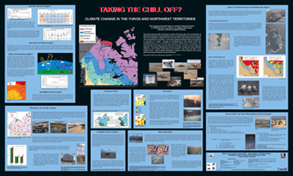
Natural Resources Canada > Earth Sciences Sector > Priorities > Climate Change Impacts and Adaptation > Curriculum Tools
Climate Change in Canada - Curriculum Tools
Science - S2 - Teacher's Resource Taking the Chill Off: Climate Change in the Yukon & Northwest Territories
Please note: These exercises are not designed to be filled out nor printed from your Web browser. Please download and print the PDF files located at the bottom of the page.
Trivia Challenge:
Search the entire poster to find answers for the following:
- Describe the permafrost in the Whitehorse region.
- Who took the picture of the polar bear on the poster?
- What bird is depicted in the NRC icon?
How Has Climate Changed?
- Examine the graph showing temperature change over the last 10 000 years.
- How many times has the temperature been above average during this time?
- Around what year in time did we see the longest period of above average temperatures?
- In Inuvik, how were temperatures of the Little Ice Age collected/derived?
- Describe the "Mean Annual Temperature" in Inuvik graph.
Why Does the Climate Change?
- What 3 events can alter climate significantly?
What is the Greenhouse Effect?
- What 2 gases mentioned absorb heat energy in the atmosphere? Do you know of any others?
- What activity contributes to extra CO2 in our atmosphere?
- What does the graph showing CO2 concentrations display for the last 200 years?
- What is the current day concentration (parts per million by volume) of CO2 in our atmosphere?
Permafrost and Climate Change:
- What might happen to the permafrost if climate warms?
- How will people be affected by thawing permafrost?
- Which of the 3 areas measured for summer thaw showed the most significant change in 1998?
A Greener North:
- What will happen to the treeline with climate change?
- What may happen to insect distribution as climate warms?
- What new types of vegetative cover will be found in the Yukon and Northwest Territories as climate warms?
A Tougher Life for Caribou?
- What insect might increasingly harass caribou with warmer temperatures?
- What might happen to the reproduction rate of caribou if climate warms?
- How might caribou changes have an impact on the people in the region?
Fire and Ice:
- Will the risk of forest fires increase or decrease in the north with expected climate changes?
- List 3 effects of excessive thawing of ice:
-
-
-
Rivers and Lakes:
- What tool/device was utilized to collect the pictures showing the Old Crow Flats in 1990 and 1994?
- Which "group" of fish may not be able to adjust to warmer waters?
Impacts of Climate Change in the Beaufort Sea Region:
- What specific types of communities are at significant risk with climate warming?
- During what years did Tuktoyaktuk experience severe storms?
- Examine the air photo taken of Tuktoyaktuk from 1947. What do the green and black lines show has happened over the last 50+ years?
- What has been proposed, and somewhat implemented since 1976?
Sea Ice and Marine Mammals
- What phenomenon extended the melt season in 1997 – 1998?
- What animal do polar bears heavily rely on for food?
- Describe the general trend of ice concentration in the area over time, comparing the 30-Year Median graph to that of September 1998.
- Why do seals suffer when ice melts quicker than usual?
How Are N.W.T. and Yukon Responding to Climate Change?
- How many tonnes of CO2 did Canada produce in 1995? Convert this to scientific notation.
- Even though emissions from the region itself are small, do global emissions affect this region with larger impacts?
- What are some alternatives to diesel fuel generators?
- What can YOU do to reduce greenhouse gas emissions, save energy and money, OTHER THAN what is listed?
Downloads:
| 
